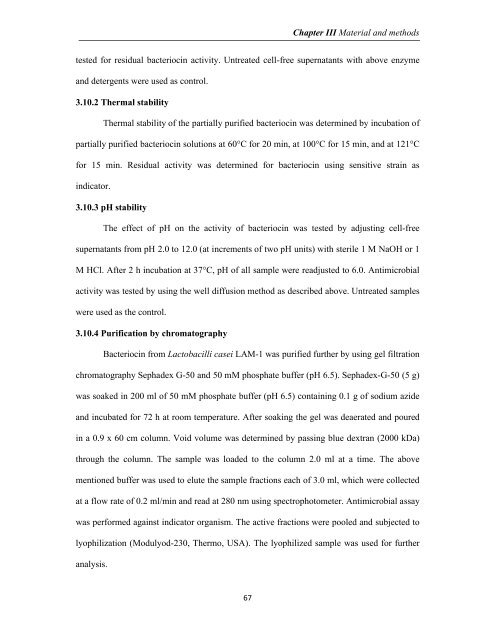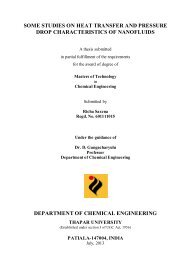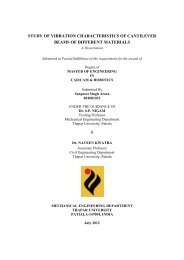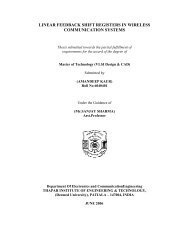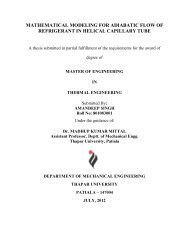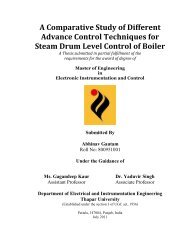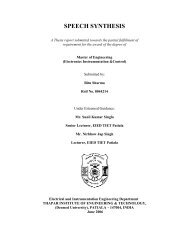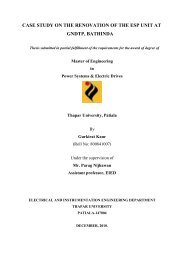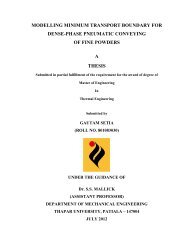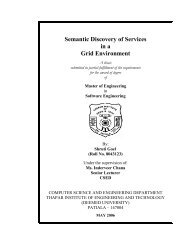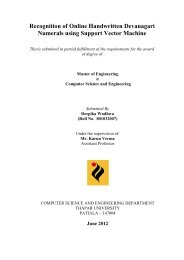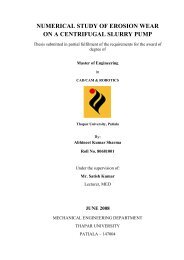from indigenous fermented foods and human gut ... - Thapar University
from indigenous fermented foods and human gut ... - Thapar University
from indigenous fermented foods and human gut ... - Thapar University
Create successful ePaper yourself
Turn your PDF publications into a flip-book with our unique Google optimized e-Paper software.
67<br />
Chapter III Material <strong>and</strong> methods<br />
tested for residual bacteriocin activity. Untreated cell-free supernatants with above enzyme<br />
<strong>and</strong> detergents were used as control.<br />
3.10.2 Thermal stability<br />
Thermal stability of the partially purified bacteriocin was determined by incubation of<br />
partially purified bacteriocin solutions at 60°C for 20 min, at 100°C for 15 min, <strong>and</strong> at 121°C<br />
for 15 min. Residual activity was determined for bacteriocin using sensitive strain as<br />
indicator.<br />
3.10.3 pH stability<br />
The effect of pH on the activity of bacteriocin was tested by adjusting cell-free<br />
supernatants <strong>from</strong> pH 2.0 to 12.0 (at increments of two pH units) with sterile 1 M NaOH or 1<br />
M HCl. After 2 h incubation at 37°C, pH of all sample were readjusted to 6.0. Antimicrobial<br />
activity was tested by using the well diffusion method as described above. Untreated samples<br />
were used as the control.<br />
3.10.4 Purification by chromatography<br />
Bacteriocin <strong>from</strong> Lactobacilli casei LAM-1 was purified further by using gel filtration<br />
chromatography Sephadex G-50 <strong>and</strong> 50 mM phosphate buffer (pH 6.5). Sephadex-G-50 (5 g)<br />
was soaked in 200 ml of 50 mM phosphate buffer (pH 6.5) containing 0.1 g of sodium azide<br />
<strong>and</strong> incubated for 72 h at room temperature. After soaking the gel was deaerated <strong>and</strong> poured<br />
in a 0.9 x 60 cm column. Void volume was determined by passing blue dextran (2000 kDa)<br />
through the column. The sample was loaded to the column 2.0 ml at a time. The above<br />
mentioned buffer was used to elute the sample fractions each of 3.0 ml, which were collected<br />
at a flow rate of 0.2 ml/min <strong>and</strong> read at 280 nm using spectrophotometer. Antimicrobial assay<br />
was performed against indicator organism. The active fractions were pooled <strong>and</strong> subjected to<br />
lyophilization (Modulyod-230, Thermo, USA). The lyophilized sample was used for further<br />
analysis.


